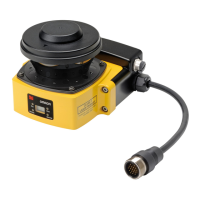2
Chapter1
OS32C
User’s Manual
Description of Use and Features
Theory of Operation
The OS32C safety laser scanner is an optical safety sensor that uses diffuse reflection of a pulsed laser light
to determine the location of objects entering a predefined monitoring zone. Internally, a spinning mirror
assembly scans a monitoring zone by sending a pulse of light which reflects off the first object in its path. The
distance from the sensor to the object is determined by measuring the time that the light requires to return
from the sensed object.
This method of sensing allows for standard, simple or irregular shapes to be used as the predetermined
sensed monitoring zones. It also allows for the monitoring zone to be changed if the hazardous area changes.
Using diffused reflection of light back to the OS32C precludes the need for a traditional transmitter/receiver
pair.
Within the sensing range of the OS32C, three fields can be monitored simultaneously: One safety zone and
two warning zones.
• One Safety Zone is used to detect personnel or other objects entering an area that has been determined to
be a hazard. Upon sensing that the object is within the Safety Zone, the OS32C will send a stop signal to the
control circuitry of the machine being guarded.
• Two Warning Zones can be defined with a longer distance than a safety zone, allowing a configuration to
detect objects that are closely approaching the hazardous area of the Safety Zone before the actual Safety
Zone is encroached.
Applications for the OS32C include mobile applications on automatic guided vehicles (AGV) or transfer carts
as well as stationary use, such as within a robotic work cell, in front of a press or around other hazardous
machinery.

